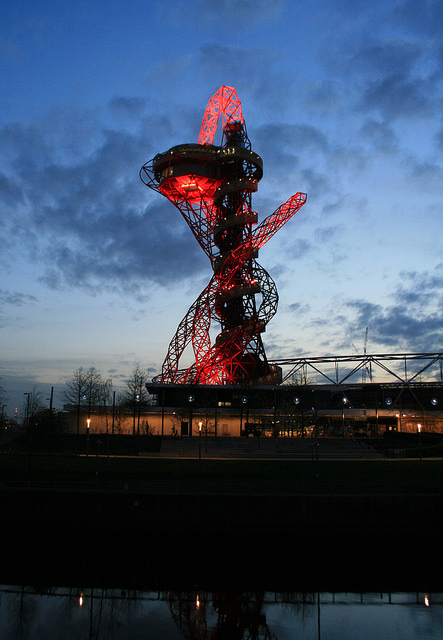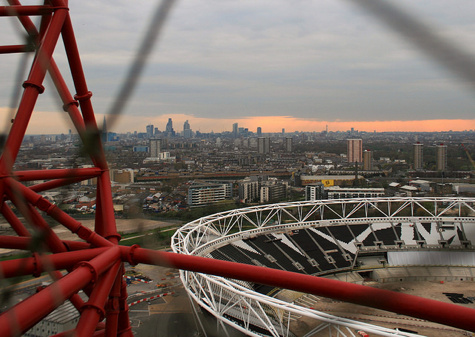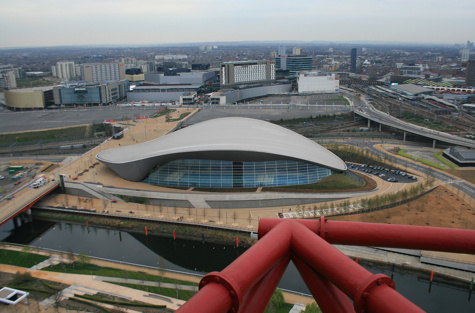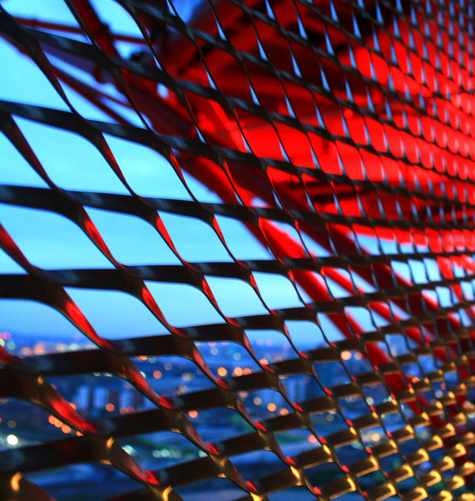
Part 2 of a writeup of a press preview tour of the Queen Elizabeth Olympic Park – thanks to Diamond Geezer for passing his invite to me – see Part 1, about the South Park itself, here.
The visit to the South Park was finished up with a trip to the Orbit – the huge red sculpture that is “Marmite” to east Londoners. I hadn’t made it up during 2012 when it was last open, what with needing a combination of a timed Olympic Park ticket and a timed Orbit ticket, both tricky to obtain, with a lot of people presumably wanting to go up it to see what was going on in the Olympic Stadium. I wasn’t convinced that, with a now empty stadium being reconstructed in a park that still has a number of other “brownfield” sites, the view would be that interesting, but was very happy to be proved wrong.
The main viewing platform at the Orbit is 80 metres high – the sculpture itself being 114m tall. That’s not nearly as high as the Shard or even the London Eye, but because east London is still relatively low-rise, and because the surrounding Queen Elizabeth Olympic Park is spacious and not crowded with the buildings of an inner city, the platform gives the illusion that you are actually quite a lot higher.
 While you wait for the lift up you can admire the giant rust-coloured metal bell which fills the lower space. The sculptor insisted on total darkness within the space, so tiny pieces of light shining through rivets and welds had to be fixed, the result is a surreal experience of being below a giant bell-shaped dome, receding into darkness and apparently suspended in mid-air.
While you wait for the lift up you can admire the giant rust-coloured metal bell which fills the lower space. The sculptor insisted on total darkness within the space, so tiny pieces of light shining through rivets and welds had to be fixed, the result is a surreal experience of being below a giant bell-shaped dome, receding into darkness and apparently suspended in mid-air.
Once up in the Orbit itself, there’s a couple of outdoor platforms, facing north-west and south-east – and also an indoor space, from where you can look south-west and also to an inner void looking down the structure of the Orbit itself. The glass was a little bit dusty (maybe from the Saharan weather we have at the moment) and also somewhat reflective, so the experience is much better on the outside platforms. Semi-pro photographers might be perturbed that the outside platforms have quite small mesh fencing, so it’s difficult to poke a DSLR camera lens through for a clear shot. Plenty of space for cameraphones though. Once you’ve drunk in the view, there are a number of helpful and enthusiastic staff in the indoor space, ready to answer your questions on what you were looking at – I tested them out on their knowledge of the Crossrail portal location and the appearance of some allotment huts and they seemed to know their stuff.

The view over into the Olympic Stadium was more complete than I was expecting – this is simply because the roof and lighting gantries are temporarily gone for the footballisation of the venue. The general city views were also excellent – the City and Canary Wharf clusters of skyscrapers being roughly the same distance away, mean they balanced rather well. Stratford itself is having a go at being a third (smaller, closer) skyscraper cluster and to some extent is managing to pull off the look. Finally, to the east the Aquatic Centre (“Come swim in the World’s Best Swimming Pool”) looks especially impressive when viewed from the Orbit – the famous, and expensive, flowing roof and huge glass side looking particularly stunning from above. Westfield is – to be honest – a bit of an eyesore from high up. Ironically, the older Stratford Shopping Centre looks more attractive, with its colourful “fish scale” wall glinting in the distance. In time, Westfield will get masked by the International Quarter development which will squeeze behind the Aquatic Centre.

The other thing to note is it’s not all about the view. The primary purpose of the Orbit is not as a building (like the Shard) or a tourist attraction (like the London Eye) but it is first and foremost a piece of public art. A very red, rather large and not at all subtle piece, but an artwork nonetheless – and unmistakably an Anish Kapoor creation. A lot of people will look at its asymmetric, organic skyline, from a distance and think it ugly. I did and still do – from a distance. It delights in being the opposite of Paris’s Eiffel Tower, with a geometry as imperfect as possible. Up close though, it reveals itself as a very complex beast and does have a subtle beauty from certain angles.
One disappointment is that the Orbit will not be open to the public in the evenings – so no great views of sunsets over central London, at least in the summer months. I suspect this is due to a nervousness that it will not attract the level of visitors needed to justify staying open in the evenings – I wonder if the struggling Cable Car has proved that not everything built in London is instantly popular. It’s a shame though as the evening is probably the best time to experience the view. Certainly, being up in the tower, when the pulsating red lights are shining on and from it in the evening, is a bit of a spectacle.

Finally, getting back down is an experience in itself. First you need to pass two large distorting mirrors – a bit of a disturbing sensation if you are already on edge from the height. Then you have 445 steps down in a spiralling cage, initially anticlockwise, then doubling back. The route is not a perfect spiral, so there are some sections with a lot of empty air below the floor! You do still get a view through the cage though, and also up to the Orbit itself.
So, I’m a bit of a convert to London’s new and unsubtle sculpture, with the proviso of course that my trip to see it was free. You want to pick a day of good weather to visit, but the shape of the Orbit itself means it’s more than just another tall building to soak up a view from – the interest is as much inward to the object itself, as outward to the park and London.